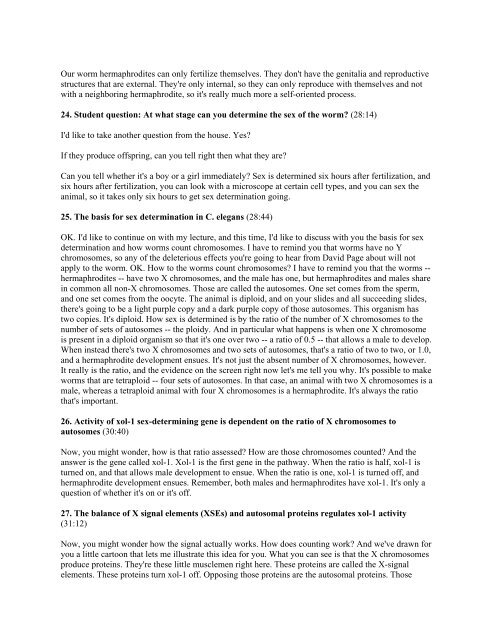The Meaning Of Sex: Genes And Gender Lecture - Howard Hughes ...
The Meaning Of Sex: Genes And Gender Lecture - Howard Hughes ...
The Meaning Of Sex: Genes And Gender Lecture - Howard Hughes ...
You also want an ePaper? Increase the reach of your titles
YUMPU automatically turns print PDFs into web optimized ePapers that Google loves.
Our worm hermaphrodites can only fertilize themselves. <strong>The</strong>y don't have the genitalia and reproductive<br />
structures that are external. <strong>The</strong>y're only internal, so they can only reproduce with themselves and not<br />
with a neighboring hermaphrodite, so it's really much more a self-oriented process.<br />
24. Student question: At what stage can you determine the sex of the worm? (28:14)<br />
I'd like to take another question from the house. Yes?<br />
If they produce offspring, can you tell right then what they are?<br />
Can you tell whether it's a boy or a girl immediately? <strong>Sex</strong> is determined six hours after fertilization, and<br />
six hours after fertilization, you can look with a microscope at certain cell types, and you can sex the<br />
animal, so it takes only six hours to get sex determination going.<br />
25. <strong>The</strong> basis for sex determination in C. elegans (28:44)<br />
OK. I'd like to continue on with my lecture, and this time, I'd like to discuss with you the basis for sex<br />
determination and how worms count chromosomes. I have to remind you that worms have no Y<br />
chromosomes, so any of the deleterious effects you're going to hear from David Page about will not<br />
apply to the worm. OK. How to the worms count chromosomes? I have to remind you that the worms --<br />
hermaphrodites -- have two X chromosomes, and the male has one, but hermaphrodites and males share<br />
in common all non-X chromosomes. Those are called the autosomes. One set comes from the sperm,<br />
and one set comes from the oocyte. <strong>The</strong> animal is diploid, and on your slides and all succeeding slides,<br />
there's going to be a light purple copy and a dark purple copy of those autosomes. This organism has<br />
two copies. It's diploid. How sex is determined is by the ratio of the number of X chromosomes to the<br />
number of sets of autosomes -- the ploidy. <strong>And</strong> in particular what happens is when one X chromosome<br />
is present in a diploid organism so that it's one over two -- a ratio of 0.5 -- that allows a male to develop.<br />
When instead there's two X chromosomes and two sets of autosomes, that's a ratio of two to two, or 1.0,<br />
and a hermaphrodite development ensues. It's not just the absent number of X chromosomes, however.<br />
It really is the ratio, and the evidence on the screen right now let's me tell you why. It's possible to make<br />
worms that are tetraploid -- four sets of autosomes. In that case, an animal with two X chromosomes is a<br />
male, whereas a tetraploid animal with four X chromosomes is a hermaphrodite. It's always the ratio<br />
that's important.<br />
26. Activity of xol-1 sex-determining gene is dependent on the ratio of X chromosomes to<br />
autosomes (30:40)<br />
Now, you might wonder, how is that ratio assessed? How are those chromosomes counted? <strong>And</strong> the<br />
answer is the gene called xol-1. Xol-1 is the first gene in the pathway. When the ratio is half, xol-1 is<br />
turned on, and that allows male development to ensue. When the ratio is one, xol-1 is turned off, and<br />
hermaphrodite development ensues. Remember, both males and hermaphrodites have xol-1. It's only a<br />
question of whether it's on or it's off.<br />
27. <strong>The</strong> balance of X signal elements (XSEs) and autosomal proteins regulates xol-1 activity<br />
(31:12)<br />
Now, you might wonder how the signal actually works. How does counting work? <strong>And</strong> we've drawn for<br />
you a little cartoon that lets me illustrate this idea for you. What you can see is that the X chromosomes<br />
produce proteins. <strong>The</strong>y're these little musclemen right here. <strong>The</strong>se proteins are called the X-signal<br />
elements. <strong>The</strong>se proteins turn xol-1 off. Opposing those proteins are the autosomal proteins. Those

















